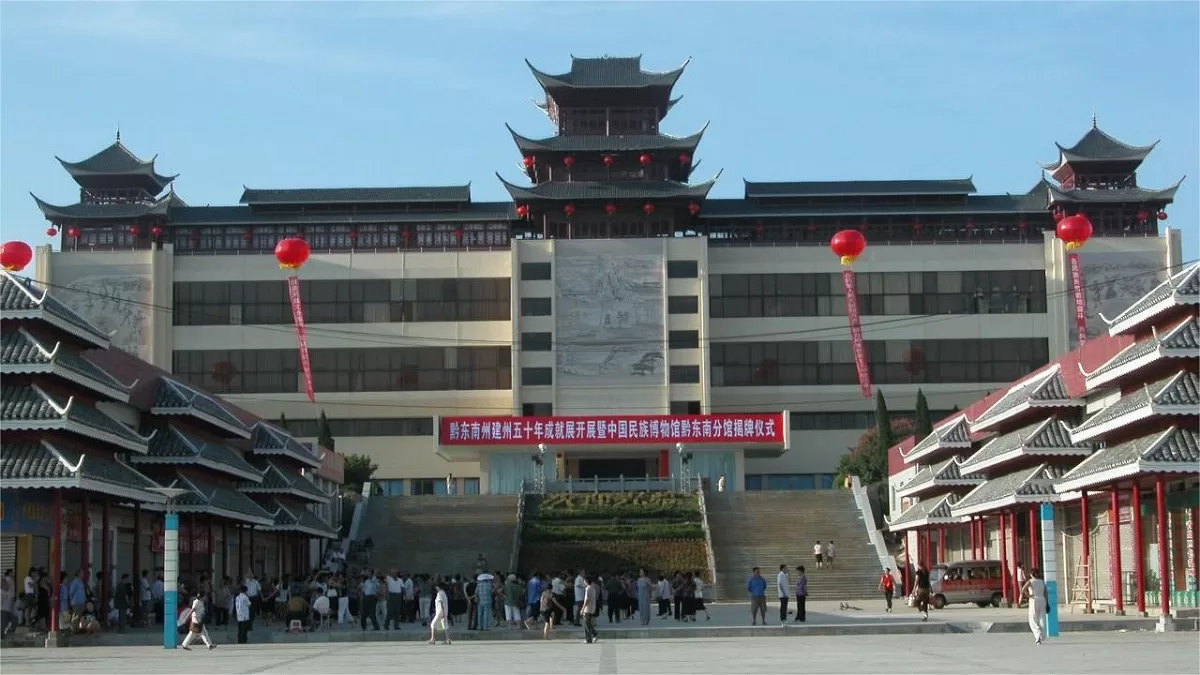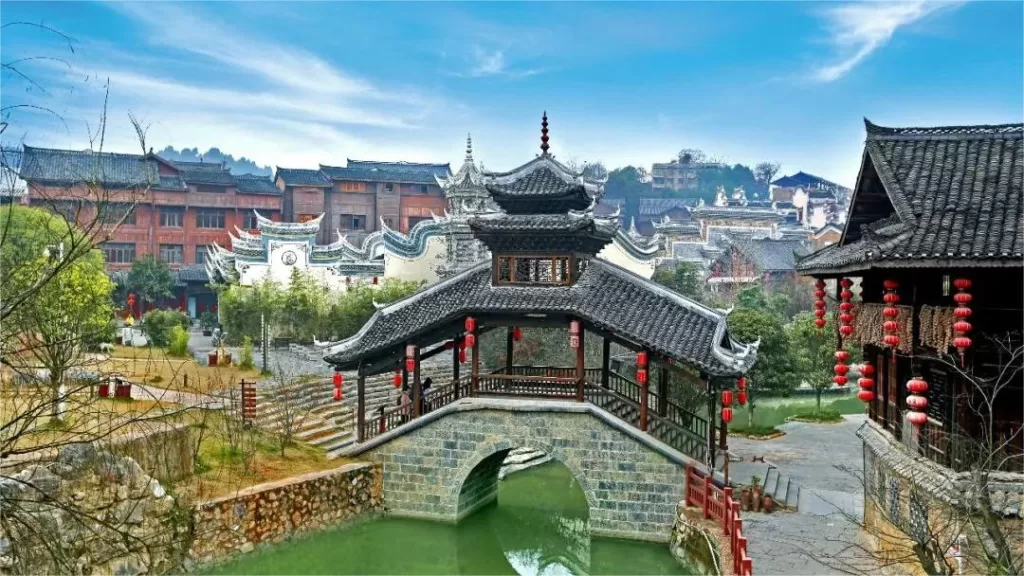The Kaili Ethnic Museum (凯里民族博物馆), also known as the Qiandongnan Ethnic Museum, is comprised of four main exhibition areas: the “State Situation Hall,” the “Ethnic Culture Hall,” the “Costume Hall,” and the “Intangible Cultural Heritage Hall.” Additionally, there is a “Temporary Exhibition Hall.” With over 12,000 exhibits, the museum showcases a diverse collection, including Miao and Dong ethnic costumes dating back to the Yuan, Ming, and Qing dynasties, as well as ancestral and daily life artifacts.
The museum’s architecture seamlessly integrates the artistic styles of Miao and Dong ethnic buildings. The central tower adopts the multi-eave structure of the Dong drum tower, while the east and west towers feature the suspended floor style of Miao ethnic houses. The exterior design emphasizes that Qiandongnan is the “Land of Miao and Dong.” The artifacts in the museum are categorized into unearthed items, revolutionary and social construction items, and items related to production and daily life, providing a comprehensive representation of the rich cultural heritage of the ethnic minorities in the region.
Table of Contents
- Basic Information
- Location and Transportation
- Highlights of Kaili Ethnic Museum
- Other Attractions in Kaili
Basic Information
| Estimated Length of Tour | 2 hours |
| Ticket Price | Free |
| Opening Hours | 9.00 – 17.00; Last admission: 16.30 Closed on Mondays |
| Telephone Number | 0086-0855-8068089 0086-0855-8065971 |
Location and Transportation
The Kaili Ethnic Museum is located at 5 Guangchang Road, Kaili City, Qiandongnan Miao and Dong Autonomous Prefecture, Guizhou Province, China. To get there, you can take bus Kaili 1, Kaili 2, Kaili 5, Kaili 6, Kaili 12, Kaili 16, Kaili 18, Kaili 21, or Kaili 25 and get off at Wanbo West Stop (万博西站).
Highlights of Kaili Ethnic Museum
State Situation Hall

The State Situation Hall is located on the first floor of the Kaili Ethnic Museum, showcasing the rich history and cultural development of Qiandongnan. Divided into seven sections, the exhibition covers topics such as “Ancient Qiandongnan,” “Long History,” “Wood Flows to the East – Culture Moves to the West,” “Peasant War,” “Activities of the Chinese Workers’ and Peasants’ Red Army in Qiandongnan,” “Olympic Torch in Qiandongnan,” and “Tourism Resources in Qiandongnan.” Through precious artifacts, the exhibition provides a comprehensive overview of the continuous development of Qiandongnan’s civilization, highlighting the significant achievements and contributions of the Miao, Dong, and other ethnic groups in politics, economy, and culture.
Ethnic Culture Hall

The Ethnic Culture Hall, situated on the second floor in two separate exhibition halls, systematically presents the daily lives, food, entertainment, marriage customs, and beliefs of the various ethnic groups in Qiandongnan. Using a variety of mediums, including physical items, photographic materials, written documents, and scene recreations, the exhibition offers an immersive experience into the diverse cultures of the people in the region.
Costume Hall

On the third floor’s west side, the Costume Hall carefully selects and exhibits exquisite and splendid clothing, embroidery, suspenders, silver ornaments, and more, primarily from the Miao and Dong ethnic groups in Qiandongnan. These visually striking displays showcase the diversity and richness of the region’s minority costumes. With a wide variety and distinct styles, these costumes represent some of the oldest and relatively well-preserved traditional attire in Chinese culture.
Intangible Cultural Heritage Hall

Located on the east side of the third floor, the Intangible Cultural Heritage Hall employs various methods, including textual and pictorial explanations, simulated scenes, and actual artifacts, to showcase the nationally, provincially, and regionally recognized intangible cultural heritage of Qiandongnan. This includes representative examples of ethnic arts, culture, sports, medicine, and other intangible cultural treasures that contribute to the unique identity of the region. The hall serves as a tribute to the diverse and vibrant intangible cultural heritage of Qiandongnan.






Our first stop in Kaili was met with disappointment as we found the museum closed. A staff member from the management came out to inform us that it has been closed for five months and it’s uncertain when it will reopen.
The Kaili National Museum is closed today, so don’t make a wasted trip.
Still undergoing renovations and upgrades, please do not come.
On a scorching hot day, I was disappointed to find the Kaili Ethnic Museum closed. The staff informed me that it has been undergoing maintenance for a while. However, the nearby Intangible Cultural Heritage Museum is open, so I could go check that out.
The Kaili National Museum is currently undergoing renovations and is temporarily closed to the public, so please do not come over.
– The exquisite traditional costumes of various ethnic groups, dazzling colors, and delicate embroidery skills, make people admire the dexterity of the ethnic peoples’ hearts.
– The model of the drum tower of the Dong ethnic group showcases a unique architectural style, carrying the history and wisdom of the Dong people.
– The Miao silver ornaments are renowned for their exquisite craftsmanship and unique designs, typically rich in symbolic meanings that reflect the culture and traditions of the Miao people.
A treasure trove museum that can be visited without reservation, just by presenting your ID.
After visiting, the Miao embroidery market pales in comparison.
It is very suitable for those who love and want to understand Miao embroidery, batik, and minority cultures.
The museum in Kaili is really worth visiting. It is said that museums can showcase the local cultural heritage and customs, and it is true. Here, not only is there an introduction to the history of the southeastern Guizhou, but also various ethnic groups. Basically, the important customs and festivals of all 56 ethnic groups are introduced. The design of the whole museum is very good. After finishing one section, you don’t need to walk around much to go to… Read more »
In the afternoon when it started raining, I casually made a simple itinerary and decided to stroll around. The museum is located near the city center, close to Fangyuan Hui (方圆荟) and Guomao Mall (国贸商场), so we went for a meal after visiting the museum. Since it was a weekday, there were not many people in the museum, so we could slowly appreciate the exhibits. The ethnic buildings and costumes inside were all very beautiful, especially the silver jewelry, truly… Read more »